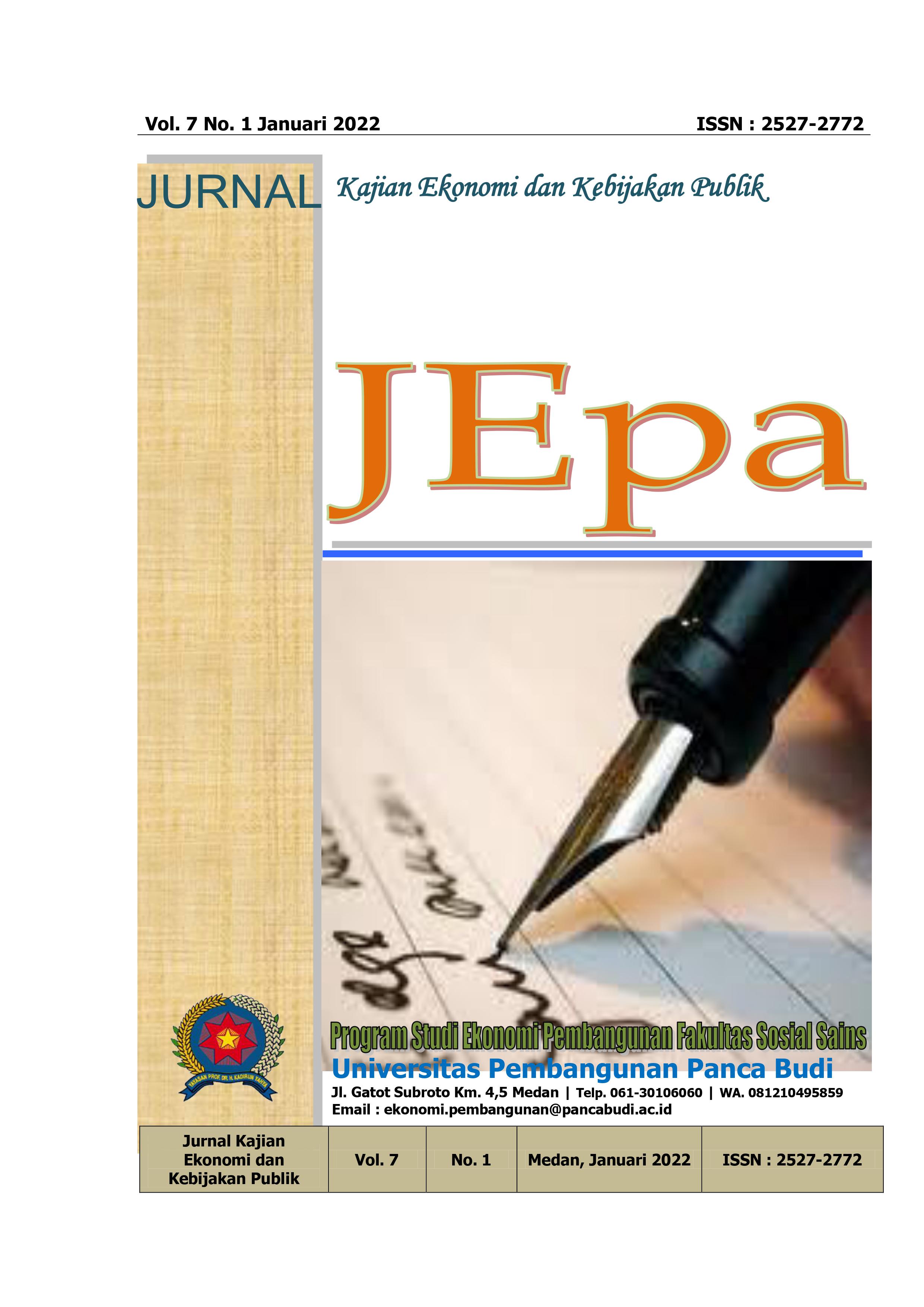DETERMINAN TINGKAT LITERASI KEUANGAN SISWA SEKOLAH MENENGAH (Studi Kasus: SMA Hidayatullah Semarang)
Abstract
Financial literacy is defined as an individual's ability to decide on his financial regulation. Financial literacy is determined by many factors, such as education, gender, and parent income, which become the purpose of this research. The population of this study was the students of Senior High School (SMA) Hidayatullah. Saturated sampling was used as the method of sampling from 131 respondents. In analyzing the data, the author applied Mann Whitney method. From the result, the writer concluded that there was no difference in senior high school students' financial literacy in SMA Hidayatullah. The students are expected to be more diligent in learning and applying their economic knowledge for the suggestion. Meanwhile, for the future researcher, it is expected to find other variables that significantly impact an individual's financial literacy to get more various research.
References
Ajzen, I. (2005) Attitudes, Personality and Behavior, Mapping social psychology. doi: 10.1037/e418632008-001.
Ariadi, Riyan, Mariana Ing Malelak dan Dewi Astuti. (2015). Analisa Hubungan Financial Literacy dan Demografi Dengan Investasi, Saving, dan Konsumsi. Finesta. Vol. 3, No. 1, Hal. 7-12.
Ariani, Nur Aziza dan Susanti. (2015). Pengaruh Faktor Demografi Terhadap Financial Literacy Mahasiswa Fakultas Ekonomi Universitas Negeri Surabaya Angkatan 2012. Jurnal Mahasiswa Teknologi Pendidikan, 3(2.
Bhusnan, P., & Yajulu Medury. (2013). Financial Literacy and it’s Determinants. International Journal of Engineering, Business and Enterprise Applications (IJEBEA). Vol. 4, No. 2, Hal. 155-160.
Chen, Haiyang and Ronald P. Volpe. (1998). An Analysis of Personal Financial Literacy Among College Students. Financial Services Review. Vol. 7, No. 2, Hal. 107-128
Coben, Diana, Margaret Dawes and Nirmala Lee. (2005). Financial Literacy Education and Skills for Life. Institute of Education (University of London): National Research and Development Centre (NRDC).Dubai Islamic Bank (2017) Islamic Finance Country Index, Global Islamic Finance Report 2017.
Cude, B. J., Lawrence F. C.m Lyons A. c., Metzger, K., LeJeune, E., Marks, L., & Machtmes, K. (2006). College Students and Financial Literacy: What They Know and What We Need to Learn. Eastern Family Economics and Resource Management Association 2006 Conference.
Ferdinand, Augusty. (2014). Metode Penelitian Bisnis: Pedoman Penelitian untuk Penulisan Skripsi, Tesis dan Disertasi Ilmu Manajemen. Edisi 5. Semarang: Badan Penerbit Universitas Diponegoro.
Fishbein, M. & Ajzen, I. (1975) ‘Belief, attitude, attitude, intention and behavior: An introduction to theory of research’, Reading, MA : Addison-Wesley Addison-Wesley, p. 578.
Ghozali, Imam. (2011). Aplikasi Analisis Multivariate Dengan Program IBM SPSS 19. Edisi 5. Semarang: Badan Penerbit Universitas Diponegoro.
Irin, Widayanti. (2012). Faktor-Faktor yang Mempengaruhi Literasi Finansial Mahasiswa Fakultas Ekonomi dan Bisnis Universitas Brawijaya. Madiun: Pendidikan Akuntansi IKIP PGRI.
Keown, L. A. (2011). The Financial Knowledge of Canadians. Component of Statictics Canada Catalogue 11-008-X, 30-39.
Krishna, A., Rofi Rofaida, dan Maya Sri. (2010). Analisis Tingkat Literasi Keuangan di Kalangan Mahasiswa dan Faktor-Faktor yang Mempengaruhinya (Survey pada Mahasiswa Universitas Pendidikan Indonesia). Proceedings of The 4th International Conference on Teacher Education; Join Conference UPI & UPSI Bandung, Indonesia, 8-10 November 2010 (November), 8–10.
Lusardi, Olivia S. Mitchell, and Vilsa Curto. (2010). Financial Literacy Among the Young: Evidence and Imlications for Cunsumer Policy.
Margaretha, Farah dan Reza Arief Pambudhi. (2015). Tingkat Literasi Keuangan Pada Mahasiswa S-1 Fakultas Ekonomi. Jurnal Manajemen dan Kewirausahaan. Vol.17, No. 1, Maret 2015, Hal. 76-85.
Mokhlis, S. (2006) ‘The Influence of Religion on Retail Patronage Behaviour inMalaysia’,Faculty of Management, Doctor of, p. 554. doi:10.1108/17590831111115268.
Nababan, D., dan Isfenti Sadalia. (2012). Analisis Personal Financial Literacy Dan Financial Behavior Mahasiswa Strata I Fakultas Ekonomi Universitas Sumatera Utara. Universitas Sumatera Utara. Hal. 1–16.
PISA. (2012). Assessment and Analytical Framework: Mathematics, Reading, Science, Problem Solving and Financial Literacy. OECD Publishing.
Sabri, M. F., Othman, M. A., Masud, J., Paim, L., MacDonald, M., & Hira, T. K. (2008). Financial Behavior and Problems Among College Students in Malaysia: Research and Education Implication. Consumer Interest Annual, 54, 166-170.
Sanusi, Anwar. (2014). Metodologi Penelitian Bisnis. Cetakan Kelima. Jakarta:
Sugiyono. (2014). Metode Penelitian Kuantitatif, Kualitatif dan R & D. Cetakan ke-20. Bandung: Alfabeta.
Usman, H. et al. (2017) ‘The role of religious norms, trust, importance of attributes and information sources in the relationship between religiosity and selection of the Islamic bank’, Journal of Islamic Marketing. Emerald Publishing Limited , 8(2), pp. 158–186. doi: 10.1108/JIMA-01-2015-0004.
Vitt, L.A., Andersen, C., Kent, J., Lyter, D. M., Siegenthaler, J. K., & Ward, J., (2000). Personal finance and the rush to competence: Financial literacy education in the U.S. Virginia: Institute for Socio-Financial Studies.




